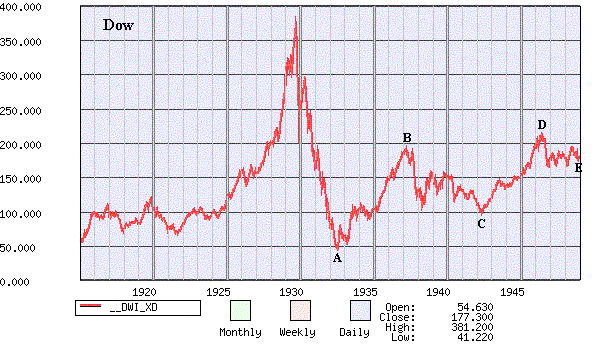|
An Analysis of Secular Bear Markets and Secular Bull
Markets since 1900
From a historical perspective since 1900 there have been 3
Secular Bull Markets and 3 Secular Bear Markets as shown by the tables below of
the Dow and S&P 500. As you can see during a Secular Bull Market the
Average Annual Return (highlighted in red) is considerably higher than during a
Secular Bear Market (highlighted in blue). Thus the long term Buy and Hold strategy
that worked well in the 1980's and 1990's for investors may have not worked very
well during the Secular Bear Markets of 1906-1921, 1929-1949 and
1966-1982.
|
Secular Bear Markets vs Secular Bull
Markets and Dow Performance
|
| Secular
Bear |
Duration |
Avg Yearly Ret |
Secular Bull |
Duration |
Avg Yearly Ret |
| Markets |
(Years) |
(Dow) |
Markets |
(Years) |
(Dow) |
| 1906-1921 |
16 |
1.58% |
1922-1928 |
7 |
17.20% |
| 1929-1949 |
21 |
1.69% |
1950-1965 |
16 |
10.60% |
| 1966-1982 |
17 |
1.59% |
1983-1999 |
17 |
15.30% |
| 2000-? |
|
|
|
|
|
| Secular Bear Markets vs Secular
Bull Markets and S&P 500 Performance |
| Secular
Bear |
Duration |
Avg Yearly Ret |
Secular Bull |
Duration |
Avg Yearly Ret |
| Markets |
(Years) |
(S&P 500) |
Markets |
(Years) |
(S&P 500) |
| 1906-1921 |
NA |
NA |
1922-1928 |
7 |
17.90% |
| 1929-1949 |
21 |
2.34% |
1950-1965 |
16 |
11.40% |
| 1966-1982 |
17 |
3.64% |
1983-1999 |
17 |
14.96% |
| 2000-? |
|
|
|
|
|
The big question is now are we in the beginning stages of
a 4th Secular Bear Market which started in 2000. The average length of the
previous 3 Secular Bear Markets was 18 years with a minimum of 16 years and a
maximum of 21 years. Thus if you add 18 years to the year 2000 and take +
or - 3 years on either side then the next Secular Bull Market may not begin
until sometime in the 2015 to 2021 time period if we are now entering a 4th
Secular Bear Market. However I would like to point out that even in a
Secular Bear Market there can still be Bull Markets lasting a year or two as the
longer term charts of the Dow show below.
Notice after the Secular Bull Market of 1922-1928 which was
followed by a Secular Bear Market from 1929-1949 that the Dow still had
impressive gains during the early to mid 1930s (points A to B) before going
through another Bear Cycle prior too and during World War II (points B to
C). This was then followed by another Bull Cycle from 1943-1946 (points C
to D). However from the early part of 1937 (point B) until the end of 1949
(point E) the Dow virtually had a net gain of 0% as its basic overall pattern
was a series of up and down movements which pretty much cancelled each other
out.

Meanwhile after the Secular Bull Market from 1950-1965 the Dow
once again went through another Secular Bear Market from 1966-1982. Notice
after the Dow peaked in early 1966 (point F) that it had a lot of upward and
downward movements from 1966 through 1982 but it basically went nowhere and
actually was lower at the end of 1982 (point G) versus its peak in early 1966
(point F).

Looking at the current chart of the Dow shows that it has been
exhibiting a choppy pattern similar to previous Secular Bear Market environments
after experiencing a Secular Bull Market from 1983-1999. One has to wonder
during the next 10 years or so whether the Dow will continue to exhibit a similar
pattern that occurred from the mid 1960's through the 1970's in which it had a
lot of downward and upward moves but the overall net gain was negligible.

Even if we go through another Secular Bear Market over the next several years
there will still be plenty of smaller Bull Markets and if taken advantage of
properly will still lead to some excellent investment opportunities in the
future.
Click here to signup for a
"Free" Two Week Trial Membership and see which Stocks will provide the
best Investment Opportunities during the next several Weeks
Other
Helpful Investing Articles
|



